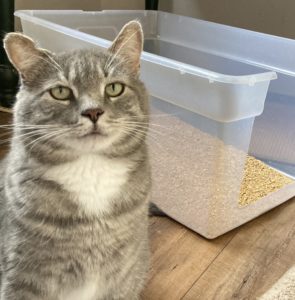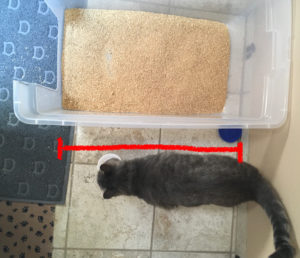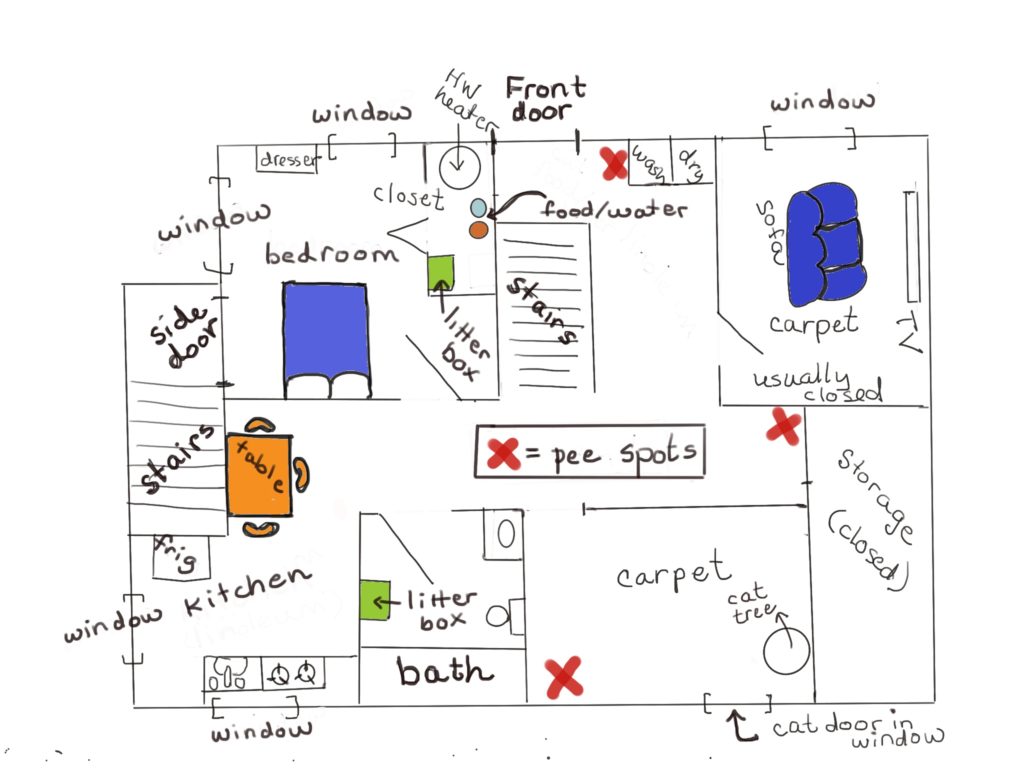 What can you do when your cat thinks outside the box?
What can you do when your cat thinks outside the box?
Whether you are waiting for an appointment with your vet or are in the process of treating a medical condition, accepted guidelines (ISFM house-soiling guidelines) recommend that you do an environmental and social assessment of your cat and where he lives. In this post, we’ll take a closer look at your cat’s environment and what we might change to resolve the house-soiling.
When Your Cat Thinks Outside the Box: First Aid
REDUCE THE TERRITORY OF THE HOUSE-SOILING CAT
The “core territory” is where the cat can rest, has shelter and feels safe from predators and other cats.
Consider temporarily confining the house-soiling cat to one or more rooms with all the cat’s resources – litter box, food and water stations, cat trees. This can make an anxious cat feel more safe – from the feline purrspective, he does not have as much area to defend from other cats, pets, and people.
DON’T HAVE THE SPACE?
- Restrict this cat’s access to the soiled areas if you can.
- If that’s not possible, try placing a litter box where the house-soiling is occurring.
- If the cat starts to use the box, keep it in place for at least 2 weeks (ISFM house-soiling guidelines)
- After two weeks of consistent use, you can gradually move the box to a more suitable location. Go very slowly for best results!
DAMAGE CONTROL
- Use an enzymatic cleaner to clean the soiled areas.
- If your cat is spraying, set up a spraying station: a litter box oriented vertically. Line walls and floor with plastic to minimize damage to wallboard and flooring.
- There is a risk of a cat marking the cleaned area, so “clean and cover”, as described above.
When your cat thinks outside the box – A CLOSER LOOK AT YOUR CAT’S ENVIRONMENT
- Sketch the floor plan of your house.

A house map showing areas where house-soiling has occurred. - Mark the location of doors, windows, stairways, closets and major pieces of furniture. Mark the location of litter boxes, feeding areas, water stations, scratching posts and sleeping areas.
- Mark where and when (extra credit!) the house-soiling has occurred.
ELIMINATION: SOCIAL OR ENVIRONMENTAL?
The house map can give us an idea of whether the elimination problem is due to your cat’s environment or if the elimination problem is social, arising from negative interactions with other cats, pets or people.
WHERE DOES “X MARK THE SPOT”?
- Near door and windows where outdoor cats come? social?
- Right next to the litter box? environmental?
- On laundry piles or bath mats? environmental/social?
- On your bed? social?
- Quiet corners? environmental/social?
- Near a noisy appliance? environmental?
AN ENVIRONMENTAL ASSESSMENT: The litter box
ENOUGH BOXES?
- Even this question is not straightforward. But let’s start with the commonsense basics. There needs to be more than one box even for one cat.
- Some cats prefer to use one box for urine and the other for feces.
- In a multi-story house, there should be a litter box on every floor the cat frequents.
- The rule of thumb is #litter boxes = # cats + 1 but this is not a hard and fast rule.
- Litter boxes need to be separated – cats view litter boxes next to each other as a single litter box.
SIZE MATTERS

How big are the boxes? Cats may turn around a few times before eliminating. The litter box needs to be large enough to accommodate this motion. The rule of thumb here is 1.5 times the cat’s length from nose to base of tail.
CLEAN ENOUGH?
A study sponsored by Nestle-Purina found that cats prefer a litter box free of clumps of urine and pieces of stool, so scooping the litter box frequently may avoid house-soiling problems. If you do not scoop the boxes daily, you may need more boxes and/or larger boxes.
LOCATION, LOCATION, LOCATION
- Litter boxes should be separated and not in areas a cat can be “trapped” in. Avoid high traffic areas frequented by lots of people and other pets.
- Avoid areas with noisy appliances. Remember that cats have one of the broadest ranges of hearing of any land mammal, hearing the low tones of the human male voice and the ultrasonic squeaks of mice. Even our electronic gizmos may be emitting sounds that can make a litter box area unpleasant.
ESTABLISHING NEW HABITS
To break the house-soiling habit, we need to REWARD the cat for using the litter box. We can do this by making the litter box more appealing and pleasant to use.
Offering a new litter box is one way to break the habit of soiling in an inappropriate place.
- Consider larger boxes with a cut out to allow easy access.
- High-sided boxes will work for cats who spray or stand up to urinate.
- It is best to ADD litter boxes at first. Once the cat has accepted the new box, you can remove the older one.
LITTER BOX CAFETERIA
- Putting several litter boxes side by side with different fillers (include the original) can give you an idea what kind of litter your cat prefers.
KEEP IT CLEAN!
- Consider having a “Litter Genie” or other disposal system next to each box so that it is convenient to scoop the box frequently.
THE BATHROOM IS SAFE!
- Some cats respond positively to pheromones. The “Feliway” Classic or Comfort Zone calming diffusers give a message of security and calmness.
- For cats who are spraying or marking, these analogs of facial pheromones tell your cat that this place is already marked.
- You can also collect your cat’s individual scent and apply it to the area around the box – wood moldings, walls…
NO SNACKS IN THE BATHROOM!
- Locate food and water away from the litter box. Cats do not eat where they eliminate and a litter box near food may discourage its use for elimination.
House-soiling can be a difficult puzzle to solve. When your cat thinks outside the box, it may be due to medical, environmental or social issues or a combination of these. A house map can help you locate the problem areas and optimize your cat’s environment. In the next post, we’ll use the house map to look for social problems that may be why your cat thinks outside the box.
Want to keep up with the world of cats? Subscribe to The Feline Purrspective!


